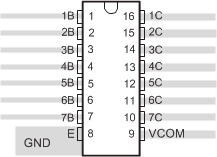SGLS148E December 2002 – December 2015 ULQ2003A-Q1 , ULQ2004A-Q1
PRODUCTION DATA.
- 1 Features
- 2 Applications
- 3 Description
- 4 Revision History
- 5 Pin Configuration and Functions
-
6 Specifications
- 6.1 Absolute Maximum Ratings
- 6.2 ESD Ratings
- 6.3 Recommended Operating Conditions
- 6.4 Thermal Information
- 6.5 Electrical Characteristics, ULQ2003AT and ULQ2003AQ
- 6.6 Electrical Characteristics, ULQ2004AT
- 6.7 Switching Characteristics, ULQ2003A and ULQ2004A
- 6.8 Dissipation Ratings
- 6.9 Typical Characteristics
- 7 Parameter Measurement Information
- 8 Detailed Description
- 9 Application and Implementation
- 10Power Supply Recommendations
- 11Layout
- 12Device and Documentation Support
- 13Mechanical, Packaging, and Orderable Information
Package Options
Refer to the PDF data sheet for device specific package drawings
Mechanical Data (Package|Pins)
- PW|16
- D|16
Thermal pad, mechanical data (Package|Pins)
- D|16
Orderable Information
11 Layout
11.1 Layout Guidelines
Thin traces can be used on the input due to the low-current logic that is typically used to drive the ULQ200xA-Q1 devices. Take care to separate the input channels as much as possible, as to eliminate crosstalk. TI recommends thick traces for the output to drive whatever high currents that may be needed. Wire thickness can be determined by the current density of the trace material and desired drive current.
Because all of the channels currents return to a common emitter, it is best to size that trace width to be very wide. Some applications require up to 2.5 A.
11.2 Layout Example
 Figure 20. Package Layout
Figure 20. Package Layout